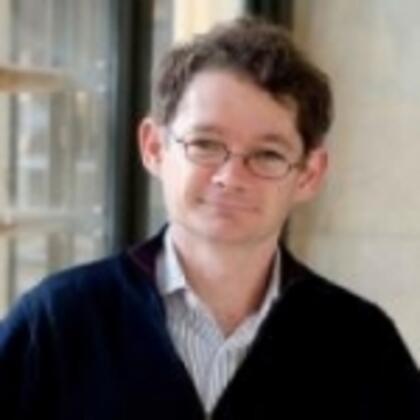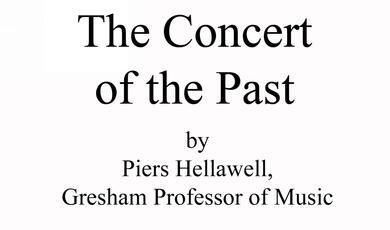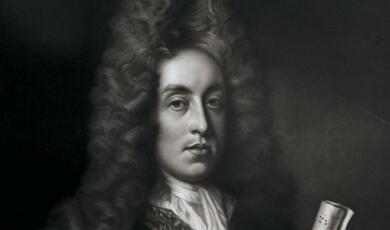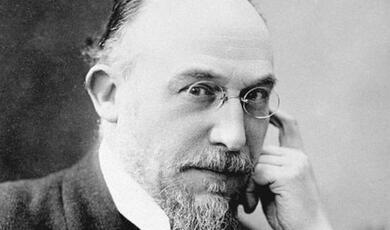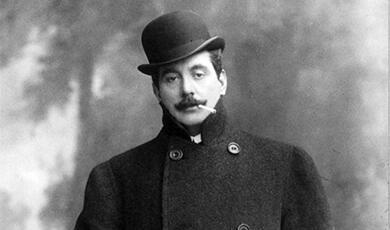Elgar and Musical Modernism: Elgar, Proust and Modernity at the fin de siecle
Share
- Details
- Text
- Audio
- Downloads
- Extra Reading
The Institute of Musical Research, University of London and Gresham College joint event. This is the third part of the all-day event. It includes the keynote address:
- A Far Country: Elgar, Proust and Modernity at the fin de siècle
- Professor Byron Adams, University of California, Riverside
- Convenors: Dr Paul Harper-Scott, Royal Holloway, University of London and Dr Daniel Grimley, University of Nottingham
Download Text
A FAR COUNTRY: ELGAR, PROUST AND MODERNITY AT THE FIN DE SIÈCLE
Professor Byron Adams
To associate the names of Edward Elgar and Marcel Proust, even in a single sentence, is to risk incredulity, skepticism, and perhaps even a touch of opprobrium. What could the golfing, bicycling English composer possibly have in common with the hypersensitive, asthmatic French novelist? Once the initial shock of incongruity has abated, however, a closer examination reveals that the two men were connected by several threads of surprising strength. Beyond the chance connections of biography, they held aesthetic premises that were common to many artists who engaged with modernity during the fin de siècle. In a comparison of Elgar with Proust, musician with author, Englishman with Frenchman, the work of the composer appears in a light that challenges parochial assumptions about his relation to European modernity during the early years of the twentieth century. Furthermore, viewing Elgar's aesthetics with Proustian vision may well bring the uncanny expressive quality of the Englishman's music into clearer focus. While this investigation takes biography as a point of departure, it will examine central analogies to suggest fresh perspectives on both Elgar's elusive creative process and his essential modernity.
The expansive modernity exemplified by the art of Proust and Elgar ended decisively with the First World War. Only the first in a series of twentieth-century cataclysms, the war utterly smashed this strain of modernity, the shards of which were refashioned into (capital-M) Modernism. In this regard, Proust's reputation fared somewhat better than Elgar's, as key elements of the French author's style accorded with post-war literary Modernism better than the English composer's idiom fared in the brave new world of Stravinsky. Despite the honors garnered by the French novelist and the English composer in the 1920s, to several generations after the Second World War, such lengthy, discursive works as Elgar's symphonies and Proust's roman fleuve, A la recherche du temps perdu, seemed to be opulent artifacts of a leisurely and self-absorbed civilization that had vanished forever; such Modernists were baffled, impatient, and, at times, repelled.
In their artistic circles, Proust and Elgar shared at least one acquaintance in common, Gabriel Fauré, whose art had a marked effect upon both men.[i] Proust was intrigued by Fauré's personality and music: in typically hyperbolic fashion, the novelist enthused to the French composer, 'Not only do I like, admire, indeed adore your music, I have for some time been and continue to be in love with it.'[ii] While it has been inferred, wrongly, that Fauré was one of the models for the otherworldly composer Vinteuil in A la recherche du temps perdu - the naïve César Franck is a more plausible candidate than the sophisticated Fauré - it is evident that Fauré's music partially inspired the sumptuous descriptions of Vinteuil's Sonata and Septet. Fauré does make an appearance in A la recherche du temps perdu - but as another, unnamed character, the description of whom makes Proust's keen understanding of Fauré's character very clear.[iii]
Elgar met Fauré through their mutual patron, Frank Schuster. Elgar wrote to Schuster, 'I was very sad over Fauré's death - he was such a realgentleman - the highest type of Frenchman & I admired him greatly. His chamber music never had a chance here in the old Joachim days I fear: I may be wrong but I feel that it was 'held up' to our loss.'[iv] As Elgar's French was as rudimentary as Fauré's English, it is doubtful that there was more than a warm mutual musical admiration between the two composers. Despite his remark about Fauré's chamber music being 'held up,' Elgar had many opportunities to hear the French composer's work as it was performed frequently in the music rooms of Schuster's two luxurious homes. Indeed, the main theme of the finale of Elgar's Second Symphony bears a remarkable resemblance to the opening theme of the first movement of Fauré's First Piano Quartet, op. 15. Passages in Elgar's late Violin Sonata and Piano Quintet suggest further that he had more than a glancing acquaintance with Fauré's First Violin Sonata and two piano quartets.
Unlike Fauré, it is almost certain that Proust never encountered the name of Edward Elgar or heard any of his music, although many leading French musicians, such as Ravel, were certainly aware of the English composer.[v] It is also entirely possible that Elgar never read a word of Proust's writings or, indeed, knew he existed. However, Siegfried Sassoon, who became part of Frank Schuster's circle after the war, was well aware of Proust's novel and may have mentioned it to Elgar. In his diaries kept in the early 1920s, the period in which he became acquainted with Elgar, Sassoon writes of reading Proust assiduously, as in an intriguing entry for November 12, 1922: 'Foggy weather. Lunched at Brook's with Roderick . . . Saw Elgar. Talked a lot about P.[roust] to Roderick.'[vi] Maddening in its lack of specificity, this entry does not disclose whether Sassoon spoke to Elgar or merely glanced at him. Certainly Schuster, who was a member of the beau monde of both Paris and London, and an acquaintance of Proust's friend the Princesse Edmond de Polignac (née Winaretta Singer), may well have heard stories of the nocturnal author who wrote in a cork-lined bedroom in his apartment on the Boulevard Hausmann.[vii] Whether Sassoon or Schuster mentioned Proust to Elgar is sadly unverifiable.
What is remarkable are the ways in which Elgar's social circle overlapped with that of Proust, as their common propensity toward social climbing propelled them into the upper reaches of society at a time when the artistic English upper classes were intimately connected with the Parisianhaut monde. Despite their apparent dissimilarities, Proust and Elgar shared a surprising number of character traits. A driving force in both lives was a fascination with - and occasional revulsion towards - high society, and both men made strenuous efforts to ascend to stratospheric heights in the fashionable world. Both were hypochondriacs who virtually demanded to be coddled: Proust by his long-suffering mother and later his housekeeper Céleste Albaret, and Elgar by his equally long-suffering wife, Alice.[viii] They both were interested in science: Proust was the son and brother of distinguished doctors, while Elgar performed chemical experiments and collected scientific treatises.
Finally, Proust and Elgar were deeply narcissistic, although their narcissism manifested itself in divergent ways. In both cases this trait enriched their art while making the lives of those around them exhaustingly difficult. Both were essentially autobiographical artists who assumed the personalities of others to express their innermost understanding of themselves and the world around them - Elgar in theEnigma Variations seeing himself as refracted through the prisms his friends' personalities and Proust in his novel with its two narrating voices, the naïve Marcel and the older Narrator, neither of which is the voice of the author.[ix] Like all great narcissistic artists, Elgar and Proust redeemed themselves in part by their lasting and precious achievements, a paradoxical generosity of spirit, and accomplishments that transcended their personal neuroses and self-absorption.
Apart from illuminations offered by biography, a number of elective affinities shared by the composer and author show them deeply engaged with the aesthetic currents of their time in similar ways. Proust was certainly the more overtly intellectual of the two, yet Elgar was a voracious reader who kept up with the latest developments in music and literature. They were attracted powerfully to the highly influential and, indeed, politically and aesthetically radical, writings of John Ruskin. Proust translated two of Ruskin's books, including Sesame and Lilies, a line from which Elgar affixed to the score of his oratorio, The Dream of Gerontius. Moreover, both were influenced by the decadent writers of the period, including Oscar Wilde.[x] (It should be stressed that the word 'decadent' is employed here as a signifier for a set of shared aesthetic premises and is used without pejorative intent.) Elgar's oratorio, The Apostles, treats the figure of Mary Magdalene in a fashion reminiscent of Wilde's evocations of that equivocal saint, while the young Proust, who may have met Wilde, was initially influenced by, and never wholly renounced, decadent aesthetics. Elgar and Proust were baptized as Roman Catholics, although, in the manner of such decadent Catholics as Paul Verlaine and Ernest Dowson, they tended to subsume many aspects of their religion into their aesthetics. Churches, stained glass windows, and cathedrals appear obsessively throughout Proust's writings as symbols of a searching analysis of religion, and were as important to him as Catholic ritual and music, and the poetry of Cardinal Newman were for Elgar.[xi]
On an equally profound level, both composer and author were influenced by the decadent's fascination with the glamour of decay. In Proust, the reader's attention is being drawn constantly to the themes of aging and death. The great final scene of Le temps retrouvé, the final volume of A la recherche du temps perdu, is a danse macabre in the guise of a soirée. Here the Narrator, acutely aware of the decay of his own body, witnesses the grotesque effects that time has wrought upon his contemporaries: the knowledge of death becomes a spur towards the writing of a novel that will redeem his prodigal waste of time. Similarly, several of Elgar's large works deal explicitly with death and dying, among them The Dream of Gerontius, The Apostles, The Music Makers and The Spirit of England. But a poignant effect of decay is achieved in certain purely instrumental scores wherein themes, such as the main theme of the finale of the 'Cello Concerto or the theme that characterizes the eponymous protagonist inFalstaff gradually disintegrate over time. Unlike Proust's, however, Elgar's dark vision only fitfully embraces the hope of ultimate redemption, even through art.
A crucial enthusiasm shared by Proust, Elgar, and the decadents was a deep love of Richard Wagner's music dramas. Remarked upon during his lifetime and noted often since his death, Elgar expropriated for his own use Wagnerian formulae, such as leitmotifs, for his three mature oratorios. Furthermore, Elgar sought to emulate the sweeping grandeur of Wagner's Der Ring des Nibelungen in a projected trilogy of oratorios, of which The Apostles and The Kingdom represent only the torso of a massive original design.
Elgar's absorption of Wagner's musical ethos put him at odds with the more conservative members of the British musical establishment and marked him, in the words of Richard Strauss, as the 'first English progressivist.'[xii] Elgar was hardly the only composer in England to champion Wagner's music, of course, as one need only mention the names of Rutland Boughton, Arnold Bax, and Granville Bantock. Indeed, Wagnerian musical modernity was a European phenomenon: in France, Franck, d'Indy, and Chausson were considered members of a radical pro-Wagner clique; in Germany and Austria, Strauss, Zeminsky, Schreker, Schoenberg, and Korngold followed the Master; in Spain, Isaac Albeniz wrote music dramas filled with leitmotifs; in Italy, Puccini was accused of having been seduced by Wagner; and in Russia, Rimsky-Korsakov adapted Wagnerian techniques for his opera The Invisible City of Kitzeh.
In his espousal of Wagnerian methods, Elgar chose the favored composer of decadent authors both in England and France. For them, especially French Wagnerites such as Baudelaire and Verlaine, an enthusiasm for Wagner signaled membership in the avant-garde; indeed, 'Wagner was one of the great inspirations for fin de siècle aestheticism' according to Ellis Hanson[xiii] The first journal exclusively devoted to Wagner, theRevue Wagnérienne, was founded in France in 1885. Eager to follow in the footsteps of Baudelaire, whose 1861 review of Tannhäuser was his only excursion into music criticism, the list of contributors to the Revue Wagnérienne is a roll-call of decadents: Huysmans, Swinburne, Mallarmé, Verlaine, and Villiers de l'Isle Adam.
Wagner had an equally potent influence upon Proust; unlike Elgar, who repeatedly visited Bayreuth, the asthmatic Proust listened to performances of Wagner's music dramas by subscribing to a service that piped opera, concerts, and theater through the telephone. Although Proust's enthusiasm for Wagner may have had its origins in the writings of the preceding generation of French decadents, the music itself exercised a profound hold upon his imagination. Proust's love for Wagner is nowhere more evident than when he writes of the shepherd's melancholy piping in the last act of Tristan: 'And, no doubt, just as the orchestra swells and surges at the approach of the ship, when it takes hold of these notes of the pipe, transforms them, imbues them with its own intoxication, breaks their rhythm, clarifies their tonality, accelerates their movement, expands their instrumentation, so no doubt Wagner himself was filled with joy when he discovered in his memory the shepherd's tune, incorporated it in his work, gave it its full wealth of meaning.'[xiv]
Such insights reveal how profoundly Proust comprehended Wagner's achievement of 'discovering [an idea] in his memory' and giving it 'its full wealth of meaning.' Indeed, the author adapted the leitmotif procedure for his novel. A well-known example of this expropriation is the petite phrase from Vinteuil's Violin Sonata that resonates throughout A la recherche du temps perdu. The petite phrase is developed, as it were, over the course of the entire narrative, appearing first as a misappropriated symbol of the jealous love of Charles Swann for the courtesan Odette de Crecy. Hundreds of pages later, the petite phrasereappears quite spectacularly in the course of a revelatory performance of Vinteuil's Septet. Over and above such details of technique, the very structure of A la recherché du temps perdu was influenced by Der Ring: just as Wagner's tetrology ends where it began with gold glimmering in the depths of the Rhine, thus setting up perpetual reenactments of the drama, so Proust reveals the endless spiral of his novel as, in the very last pages, the narrator resolves to transcend time by writing the very book the reader is about to complete. [xv]
Musing on Wagner's achievement, Proust's narrator reflects that music 'helped me to descend into myself, to discover new things.'[xvi] The value he places upon introspection here serves as a reminder that the fin de siècle saw the rise of searching philosophical and psychological inquiry. Figures such as Henri Bergson, William James, and Sigmund Freud speculated on human constructions of time; how memory functioned; the nature of the unconscious mind as revealed by dreams; and the decisive importance of early childhood experience.
Elgar and Proust engaged with these sites of modernity as well. Elgar was certainly the more instinctual of the two, but his music, both in the texts which he set and the musical processes that he evolved, can be discussed in terms of the of 'unconscious memory,' which Proust referred to asmoments bienheureux. This process of involuntary remembrance is the touchstone - the 'open sesame' - of Proust's great novel.
The first of such revelations in A la recherche du temps perdu is the famous scene starring a cup of lime tea and a madeleine: 'I raised to my lips a spoonful of the tea in which I had soaked a morsel of the cake. No sooner had the warm liquid mixed with the crumbs touched my palate than a shudder ran through me and I stopped, intent on the extraordinary thing that was happening to me . . . this new sensation having had on me the effect which love has of filling me with a precious essence . . . And suddenly the memory revealed itself . . . the whole of Combray and its surroundings . . . sprang into being, town and gardens alike, from my cup of tea.' Proust's particular formulation of 'unconscious memory,' the conviction that the past, and quite specifically childhood memories, can be recaptured through sensation, is a rendering of Baudelaire's 'synaesthesia' modified by concepts articulated in the first two books by the philosopher Henri Bergson (1859-1941).[xvii]
Bergson was fascinated by music and frequently refers to it in his first book, Essai sur les données immediates de la conscience (1889; translated as Time and Free Will), as when he employs a musical metaphor to describe consciousness itself: 'Or yet again we are to think of an invisible musician playing behind the scenes while the actor strikes the keyboard the notes of which yield no sound: consciousness must be supposed to come from an unknown region and to be superimposed on the molecular vibrations, just as the melody is on the rhythmical movements of the actor.'[xviii] In his influential second book, Matter and Memory (1896), Bergson theorizes about unconscious memory in terms that profoundly influenced Proust and his contemporaries, especially when the philosopher asserts that 'once the memory trace has been connected to the present perception, a multitude of events contiguous to the memory trace immediately attach themselves to the perception.' Such insights made Bergson, who was awarded the Nobel Prize for Literature in 1928, a figure of potent influence through the fin de siècle until the Second World War: his eminence rivaled that of Freud and Einstein.
Just as Proust appropriated Bergson's insights for his own purposes, so Elgar's music reflected an engagement with contemporary issues surrounding the apprehension of time and the functioning of memory, especially the retrieval of childhood memory. That Elgar probably never read Bergson - although he may have read something of the French philosopher's political activities during the First World War - does not necessarily mean that he was completely isolated from the philosophical speculations of his era. In 1902, Elgar received the rather curious Christmas gift of the Ellis translation of Wagner's complete writings. If Elgar, as was his habit, read these volumes carefully, he would have necessarily been introduced to Wagner's (admittedly half-digested) expropriation of certain basic concepts drawn from Schopenhauer; Schopenhauer in turn had made a deep impression upon Bergson.[xix](In addition to Wagner's writings, Elgar also received the present that Christmas of the Encyclopaedia Britannica. This gift prompted him, Robert Anderson notes, to read 'far and wide.'[xx])
Just as Proust gave a prelapsarian glow to his narrator's reminiscences of Combray, Elgar invested certain of his childhood memories with a numinous quality. Elgar's works about childhood, often characterized - and sometimes dismissed - as nostalgic souvenirs of a supposedly happier time, can be seen as visitations of 'unconscious memory.' Elgar made a point of preserving the artifacts of his early years, both his first attempts at composition and the books that he used for his self-education. While such behavior is not unusual for obsessive personalities, what is unusual is the way that Elgar returned to his early sketches with such regularity: what is reputedly his first preserved attempt at composition from 1867 is used as the basis of the seventh movement, entitled 'Fairies and Giants,' in the first Wand of Youth Suite; a minuet dating from 1878 reappears decades later in the Severn Suite (1930); and a hymn tune from 1878 is used in the first movement of the Nursery Suite. There are several more examples of this practice, and Elgar may well have returned to earlier sketch books that have not survived.
Then there is the curious case of the 'moods of Dan,' a series of short inventions called into being by Dan, the unprepossessing dog kept by Elgar's friend, George Robinson Sinclair, organist of Gloucester Cathedral. The first of the 'Moods of Dan,' entitled 'He Sleeps,' was written into Sinclair's guest book on June 5, 1897, and several other 'moods' followed over the next two days. Elgar returned to illustrating Dan's daily round in December of the same year. Thematic fragments from the 'Moods of Dan' appear in number eleven of the Enigma Variations, in which the theme is refracted through the personalities of both Sinclair and his pet. But themes from the 'Moods of Dan' cluster crop up in scores that are quite unrelated to canine activity, such as The Dream of Gerontius, In the South, and, most incongruously, Elgar's 'war requiem,' The Spirit of England.
If the early pieces and the 'Moods of Dan' are considered in light of themoments bienheureux experienced by Proust, when sensory stimuli such as taste, touch, sight, or sound conjure up a vivid recollection from the depths of the unconscious, then Elgar's repeated return to these materials can be considered in a new and striking light. Recall that the vast majority of Proust's unconscious memories dealt with recapturing his earliest experiences; so, too, for Elgar, the recollections triggered by the sound of his early compositions enabled him to gain access to the deepest sources of his creativity. Even the mysterious use of the 'moods of Dan' may be understood in light of Elgar's childhood, for throughout his youth the composer had kept dogs - until 1889, when he married Alice Roberts, who was not fond of animals. Elgar's amused observations of Dan's behavior may well have triggered a series of moments beinheureux that transcended the mundane circumstances that prompted them; thus the melodic fragments associated with Dan were less illustrative his doggy life than they were intense - and abstractly musical - expressions of Elgar's own very human and complex inner life. Just as the bland tea and madeleine were not important in themselves except as a portal to the submerged memories that constituted the raw material of a work of art, so Dan's antics prompted a rush of music arising from deep within Elgar's unconscious that could be used appropriately in a wide variety of expressive contexts. A characteristic of such moments bienheureux is that they are unexpected: whether the memory itself is joyous or grief-stricken, the act of remembrance often brings the artist an exhilarating onrush of creative energy.[xxi]
In addition, Elgar shared the fascination with dreams evinced by Bergson, Proust, and certain of the composer's British contemporaries, such as J.M. Barrie. The landscape of dreams pervades Elgar's work. The Dream of Gerontius is only the most obvious example, but several other scores can be cited in this regard, such as 'Sea Slumber-Song,' of Sea Pictures, The Starlight Express, the 'dream interludes' in Falstaff, or The Music Makers, which, as in Gerontius, combines both dreams and death. Even in as supposedly abstract a work as the Violin Concerto, for example, the beautifully protracted cadenza in the finale seems poised in a liminal realm between sleep and waking. The two wistful pieces that Elgar entitledDream Children after Charles Lamb's eerie little tale sound like the haunted revenant of a despairing dream narrative.[xxii] As with Proust, Elgar knew that vivid recall of painful memories - moments malheureux -can ignite the creative process as well.
Underlying the psychological explorations that characterized intellectual attitudes during the fin de siècle were a series of speculations on the nature of time itself. Both Elgar and Proust were well aware of the scientific revolution set in motion by the publication in 1916 of the paper in which Albert Einstein set forth the theory of relativity. Before Einstein, Bergson, who was a prodigious mathematician as well as a philosopher, had made a crucial distinction between chronological time and psychological time. Carlo Caballero has elegantly summarized Bergson's hypotheses in relation to music:
Bergson wished to reveal and analyze those forms of consciousness he believed that earlier philosphers . . . had neglected or distorted in their representations. . . It was certainly not divisible, measured time that seemed to Bergson to pose the most profound questions for human experience, but la durée toute pure, a temporality irreducibly continuous and heterogeneous, divisible only by changes in quality and not quantity. Of this virtual time the durations of our actual clocks cast only an undifferentiated shadow, a spatial and homogeneous representation . . . Because Bergson thought music possessed certain analogies with la durée pure, he constantly appealed to these analogies at critical moments in his writing.[xxiii]
Bergson's theory articulates Wagner's practice, for the German composer's music dramas are designed to alter the listener's perception of time, and to do so through a combination of psychological and aesthetic manipulation. Like Bergson's durée pure, Wagner's conception of time is that of a continuous, homogeneous, and mutable entity that exists apart from spatial categories. To change the listener's perception of time requires a large canvas, whether it is a music drama, a concerto, or aroman fleuve. A partial list of expansive post-Wagnerian scores that alter time-perception might include César Franck's Psyché (1888); Bruckner's Eighth Symphony (1890); Mahler's Third Symphony (1896); Busoni's Piano Concerto, op. 39 (1904); and Elgar's Violin Concerto (1910). Such post-Wagnerian modernity was evinced in other arts as well: John Singer Sargent's murals in the Boston Public Library, executed between 1895 and 1916, are just one example of Wagnerian scale transmuted into painting; George Bernard Shaw's mammoth 1903 play Man and Superman brings Wagnerian scope to the contemporary stage; while in literature, of course, there is not only Proust's great fresco of a novel, but also Romain Rolland's series of novels published completed in 1912, Jean-Christophe.
The scale of Elgar's major works expanded dramatically after 1902, due to part to his second pilgrimage to Bayreuth, during which he attendedParsifal (for the third time in the Festspielhaus) and the first three music dramas of the Ring. This change is evident when the length of The Dream of Gerontius is compared to the combined duration together of The Apostles and The Kingdom (remembering that they were originally planned as parts of a whole) or the scale of the concise Enigma Variations is compared to that of the massive First Symphony. Under the influence of Wagner, and in accord with the aesthetics of modernity as embraced by the progressive artists among his contemporaries, Elgar undertook a series of formal and aesthetic experiments, strikingly reminiscent of his chemical operations of 1905-08, into the nature of musical time.[xxiv]
Elgar's extraordinary contribution was the development of inimitable stylistic techniques that allowed him to achieve the auditory illusion of the cessation of time's passing. Such uncanny moments - passages that seem to combine the ultimate form of Bergson's durée pure with Proust'smoments bienheureux - are scattered throughout Elgar's oeuvre: the opening of the second part of The Dream of Gerontius, during which the Soul of Gerontius sings the line 'I hear no more the busy beat of time'; the first movement of Dream Children; the rapt theme that appears near the end of the First Symphony's slow movement upon the sketch of which Elgar scribbled a phrase from Hamlet 'the rest is silence'; the cadenza of the Violin Concerto, where teleology seems to dissolve and the music eerily assumes the quality of pure contemplation; and, as we have heard, the haunting 'dream interludes' in Falstaff. These are just a few such passages when the busy beat of time is hushed and listeners are enveloped in an uncanny sonorous stillness. At these moments Elgar appears at his most radical, truly the 'first English progressivist composer.'
Towards the end of his life, Elgar recaptured his childhood in one of his last completed works, the underrated Nursery Suite (1930). Dedicated by the elderly Master of the King's Musick to the little Princesses Margaret and Elizabeth, it was not, however, written solely for the delectation of two royal children, but doubtless as the result of several late-bloomingmoments bienheureux. 'The Wagon Passes' encapsulates in miniature two aspects of the Proustian experience, as it recaptures vividly a single 'unconscious memory' and has a circular form that ends where it begins, marking the passage of time in a curiously poignant fashion along the way. The final movement, 'Dreaming - Envoy,' pays homage to 'Der Dichter spricht,' the epilogue of Schumann's Kinderszenen, but here the voice is not that of the poet, but of the elderly composer, who chooses the violin, the beloved instrument of his youth when he steps from behind the curtain of aesthetic distance and address his hearers directly. Floating in a liminal space like the Violin Concerto's cadenza, the cadenza-like passages for violin in 'Dreaming - Envoy' sum up the themes in a way that suggests remembrance rather than recapitulation; Anderson insightfully sums up this tender score as a 'farewell to the ideas of [Elgar's] boyhood.' In this late work, Elgar has entered once again into his own particular world, a far country described by Proust, the rare author who understood so deeply composers and their music:
Each artist seems thus to be the native of an unknown country, which he himself has forgotten. . . Composers do not actually remember this lost fatherland, but each of them remains all his life unconsciously attuned to it; he is delirious with joy when he sings in harmony with his native land, betrays it at times in his thirst for fame, but then, in seeking fame, turns his back on it, and it is only by scorning fame that he finds it when he breaks out into that distinctive strain the sameness of which - for whatever its subject it remains identical with itself - proves the permanence of the elements that compose his soul.[xxv]
[i] One other possible shared acquaintance may have been the American-born painter John Singer Sargent, but while Elgar encountered Sargent several times, it is not certain that Proust was ever introduced to the artist who painted his friend, Dr. Samuel Pozzi.
[ii] Jean-Michel Nectoux, Gabriel Fauré: His Life Through His Letters, trans. J.A. Underwood (London: Marion Boyars Publishers, 1984), 206.
[iii] Proust provides a distinctly unsentimental portrait of Fauré when the author clearly uses the composer as a model for the morally lax but distinguished musician who abets the liaison between the flamboyantly homosexual Baron de Charlus and the bisexual violinist Morel. Although Proust tended to disguise situations drawn from Parisian gossip when he imported such tales into his novels, in this case the camouflage is so flimsy as to be transparent: Robert de Montesquiou, Proust's principal model for Charlus, introduced Fauré to the poetry of Verlaine, wrote the text (after the fact) for Fauré's Pavane and was one of the composer's most vociferous supporters, while Leon Delafosse, upon whom the character of Morel is predicated, performed an all-Fauré recital in St. James Hall, London, in 1898. While Fauré is unnamed, everything in this passage points directly to him: 'An eminent musician, a member of theInstitut, occupying a high official position . . . appeared at one of the Verdurin's Wednesdays. M. de Charlus was especially polite to him (at Morel's request), principally in order that on his return to Paris the Academician would allow him to attend various private concerts, rehearsals and so forth at which the violinist would be playing. The Academician, who was flattered, and was moreover a charming man, promised to do so and kept his promise. The Baron was deeply touched by all the kindness and courtesy which this important person (who, for his own part, was exclusively and passionately a lover of women) showed him . . . But M. de Charlus never suspected that he owed the maestro all the more gratitude in that the latter, doubly deserving, or alternatively guilty twice over, was fully aware of the relations between the young violinist and his noble patron. He abetted them, certainly not out of any sympathy for them since he was incapable of understanding any other love than the love of women, which had inspired the whole of his music, but from moral indifference, a kindness and readiness to oblige characteristic of his profession, social affability, and snobbery.' Marcel Proust, Remembrance of Things Past: The Cities of the Plain, Part Two, Chapter Three, trans. by C.K. Scott Moncrieff and Terence Kilmartin (New York, Random House, 1982), 1081.
[iv] Jerrold Northrop Moore, ed., Edward Elgar: Letters of a Lifetime(Oxford: Clarendon Press, 1990), 388.
[v] Ravel opined to Vaughan Williams that Elgar was 'tout à fait Mendelssohn.' See Ralph Vaughan Williams, National Music and Other Essays, ed. Michael Kennedy (Oxford: Oxford University Press, 1987), 191.
[vi] Siegfried Sassoon, Diaries 1920-1922, ed. Rupert Hart-Davies (London: Faber and Faber, 1981), 288.
[vii] Both Schuster and the Princess de Polignac attended the premiere of Fauré's 'lyric tragedy,' Prométhée, at Béziers in 1900. J. Barrie Jones, ed. and trans., Gabriel Fauré: A Life in Letters (London: B.T. Batsford, 1988), 98, 100.
[viii] Both were justified in their hypochondria. Proust suffered profoundly from asthma while Elgar was diagnosed Meniere's Disease in 1912.
[ix] For a discussion of Elgar's paradoxical strategy of seeing himself through the personalities, see Byron Adams, 'The 'Dark Saying' of the Enigma: Homoeroticism and the Elgarian Paradox' in Queer Episodes in Music and Modern Identity, ed. Sophie Fuller and Lloyd Whitesell (Urbana and Chicago: University of Illinois Press, 2002), 216-244.
[x] For Elgar's engagement with decadent aesthetics, see Byron Adams, 'Elgar's Later Oratorios: Roman Catholicism, Decadence and the Wagnerian Dialectic of Shame and Grace' in The Cambridge Companion to Elgar, ed. Daniel M. Grimley and Julian Rushton (Cambridge: Cambridge University Press, 2004), 81-105. For Proust's fleeting meeting with Wilde, see William C. Carter, Marcel Proust (New Haven and London: Yale University Press, 2000), 125-26.
[xi] For a searching discussion of Elgar's cultural Catholicism, see Charles Edward McGuire, 'Measure of a Man: Catechizing Elgar's Catholic Avatars,' in Edward Elgar and His World, ed. Byron Adams (Princeton: Princeton University Press, 2007), 3-38.
[xii] Robert Anderson, Elgar (New York: Schirmer Books, 1993), 54.
[xiii] Ellis Hanson, Decadence and Catholicism (Cambridge, Mass: Harvard University Press, 1997), 27.
[xiv] Marcel Proust, The Captive, 158.
[xv] Proust managed, just barely, to finish his masterpiece before death overtook him; Elgar abandoned his trilogy of oratorios for a variety of reasons, among them changes of musical fashions as well as the gradual ebbing away of his religious convictions. That Proust succeeded in his grand design where Elgar failed is less to the point, however, than that both of these projects engaged with a Wagnerian modernity that came to a climax during the early years of the twentieth century and, as has been noted previously, was cut off, perhaps prematurely, by the First World War. After the war, music historians were perhaps too eager to inscribe as historical fact Debussy's notorious comment that Wagner was a 'beautiful sunset that was mistaken for a dawn.' Many factors contributed to the evolution of this historical narrative after the First World War, but it is clear that after 1918 an allegiance to Wagner, hitherto the proud badge of a progressive, became - if not overnight then remarkably quickly - a stain of irrelevance.
[xvi] Ibid., 156.
[xvii] Bergson was distantly related to Proust through marriage, and read a short paper praising Proust's translation of Ruskin's The Bible of Amiensto the Académie des sciences morales et politiques in 1904.
[xviii] Henri Bergson, Time and Free Will: An Essay on the Immediate Data of Consciousness, trans. F.L. Pogson (New York, Harper and Row, 1910), 147.
[xix] For a discussion of Bergson's debt to Schopenhauer, written during the lifetimes of both Elgar and Proust, see Günther Jacoby, 'Henri Bergson, Pragmatism and Schopenhauer,' The Monist: A Quarterly Review Devoted to the Philosophy of Science, 22 (1912), 593-403.
[xx] Anderson, Elgar, 58.
[xxi] For an illuminating discussion of these moments bienheureux, with a compilation of their appearance in A la recherche du temps perdu, see Roger Shattuck, Proust's Way: A Field Guide to In Search of Lost Time (New York: W.W. Norton, 2000), 124-126, 257-264.
[xxii] Lamb's narrator, John Elia, whose multivalent points of view anticipate Proust's shifting narrative voices, relays a dream of evanescent domestic bliss that ends with the poignant recall of his brother's death.[xxii] That Elgar was drawn to Lamb's story in 1902, the year of his beloved mother's final illness, a circumstance that may well have called up unbidden painful childhood memories, is hardly surprising. The death of Elgar's younger brother Joseph in 1866 seems to have been especially traumatic. As late as 1916, in a letter to Alice Stuart-Wortley posted at a time of illness, depression and vulnerability, Elgar refers to the trauma and insecurity of his brother's death some fifty years' before: 'Everything pleasant & promising in my life is dead - I have the happiness of my friends to console me as I had fifty years ago. I feel that life has gone back so far when I was alone & there was no one to stand between me & disaster.' See Jerrold Northrop Moore, Edward Elgar: The Windflower Letters. Correspondence with Alice Caroline Stuart Wortley and Her Family(Oxford: Clarendon Press, 1989), 172.
[xxiii] Carlo Caballero, Fauré and French Musical Aesthetics (Cambridge: Cambridge University Press, 2001), 38-9.
[xxiv] In 1908, Elgar even invented a chemical device called 'The Elgar Sulphuretted Hydrogen Apparatus.' See Anderson, Elgar, 86-7.
[xxv] Proust, Remembrance of Things Past: The Captive, 258-59.
©Professor Byron Adams, Gresham College, 14 December 2007
Part of:
This event was on Fri, 14 Dec 2007
Support Gresham
Gresham College has offered an outstanding education to the public free of charge for over 400 years. Today, Gresham College plays an important role in fostering a love of learning and a greater understanding of ourselves and the world around us. Your donation will help to widen our reach and to broaden our audience, allowing more people to benefit from a high-quality education from some of the brightest minds.


 Login
Login



